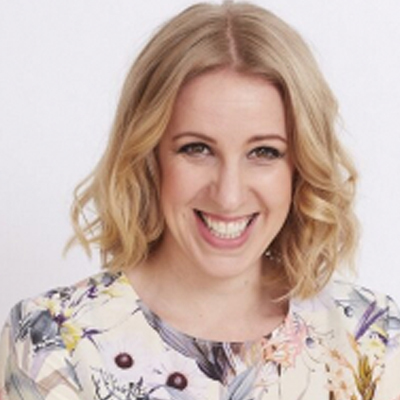How to get a stronger core
Discover how to get a stronger core and why it helps with flexibility, posture, reducing back pain and more
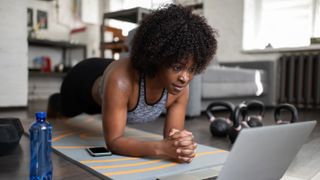
Want to know how to get a stronger core? To start with, understand that the core is more than just the abs – it’s a collection of muscles that stabilize and move the spine and form the base of support for your body.
If you've ever Googled "What are core muscles?", chances are you'll know that improving core strength is not just about looking good or having a six-pack. We need strong core muscles to help us complete daily activities, from getting out of bed and bending down to turning around and standing upright.
But a weak core could mean you are more likely to have poor posture, lower back pain and bad balance, and it makes exercising harder, too. What is the secret to getting a stronger core? We’ve asked an expert for tips and tricks on improving core strength. If you're looking for more inspiration, you could also try one of the best ab rollers and check out our article on ab roller exercises to try out at home.
- Related: How to get stronger
How the core works
Why are core muscles important? Well, personal trainer, and owner of the StudioBelle gym, Angie Bell says: “The core muscles provide postural control and stability, and they also connect your upper body to the lower body, helping to transfer forces from one to the other.”
People often think of the core as one muscle but there are several. “The main core muscles include your transverse abdominis, sometimes referred to as the ‘corset’, the internal and external obliques, which help you bend, twist and do other spinal movements, the diaphragm, pelvic floor muscles, and the ‘six-pack’ or abs muscle, the rectus abdominis,” says Bell. But that’s not all.
Your minor core muscles also include the lats, traps and glutes – they all have their own purpose to help support and stabilize your spine or pelvis.
“The core muscles fire up prior to activity and this signals to our nervous system that something is about to happen, so the core braces for support. A weak core means that other muscles will take the strain, likely causing lower back pain or injury,” says Bell.
She adds: “Core strength is important for exercise even for moves that aren’t specifically targeting the abs. Working on core stability could even help you perform better in workouts, too.” A study in the Journal of Strength and Conditioning Research found that runners who did six weeks of core strength training increased their speed in a 5,000m run.
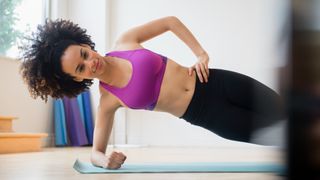
Benefits of a strong core
“A strong core will not only help you do sit ups and crunches better, it will support the body as it moves,” says Bell. “When you train the core, your lower body will get stronger as a result. This is particularly important if you like weightlifting, as it will protect your back muscles and means you are at less risk of injury. By contrast, weak core muscles can lead to poor posture and lower back pain.”
Are you a fan of running? Your core muscles keep you upright when you run and allow the pelvis, hips and lower back to work together.
“Your arms and legs are connected to the core, so the stronger this is, the stronger your limbs, so core strength could even help you to run faster,” says Bell.
Core exercises stimulate the cerebellum, an area of the brain responsible for co-ordination, spatial awareness and balance – so a core workout is as good for your body as it is for your mind.
Core exercises to try
Glute bridges
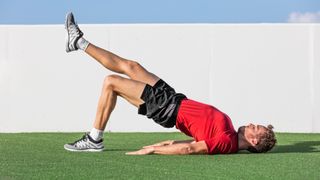
While the sit-up or crunch may seem the most obvious core exercise to gain strength, there are lots of others that are just as, if not more, effective, according to Bell. If you’re new to exercise then glute bridges are a good core move to start with.
“This activates your glutes to lift your hips, which helps to strengthen the core while toning your thighs and butt," explains Bell.
To perform them, lie on the floor with your feet on the ground and knees pointing up. Keep your hands and arms lying next to you. Then lift your hips off the ground so that they form a straight line with your knees. Hold for three seconds before easing back down.
If you want to make it even more challenging, try extending one leg at at time while you're at the top of the position.
Toe taps

"Toe taps are good because you’re lying down while doing them, so they take the pressure off the 'trunk' – useful if you are prone to back pain," says Bell.
Fancy giving them a try? Start by lying on your back with your legs in tabletop position and your hands tucked under your back, as shown in the image above. Then lower your right leg and foot to gently tap the floor, while your other leg remains in the air. Make sure you keep your knee bent at a 90° angle throughout the movement. Once you've tapped the floor, return your leg to its original position, then do the opposite leg.
Dead bug
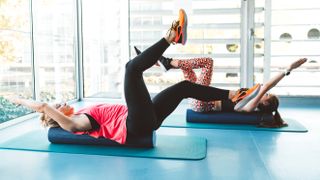
“Dead bugs are another great beginner exercise for core strength as they are easy to do without putting pressure on your back,” says Bell.
Start by lying on your back again, with your knees in tabletop position – as you did for the previous exercise. This time though, you'll also need to extend your arms above you so that they are pointing towards the ceiling. Engaging your core, lower your right arm behind you while you extend your left leg towards the floor; both limbs should be a few inches off the ground. Slowly return your limbs to their original positions then perform the exercise again on the other leg and arm.
Resistance training
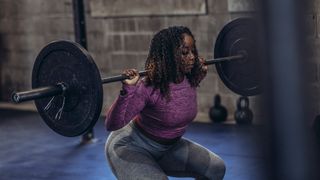
If you want to get a stronger core incorporate resistance training into your workouts. “Compound moves that work multiple muscle groups are a great way to improve core strength. Squats and deadlifts are great examples. I also love the plank because it fires up the core and targets the deeper abdominal muscles,” says Bell.
“Standing exercises put more pressure on the core to stabilize, so an exercise like a barbell squat is a good one to try. I love kettlebells for body conditioning and a kettlebell swing or single-arm kettlebell push-press are good moves to get a stronger core. The swing in particular is driven by the lower body targeting the glutes, abs, hamstrings and posterior chain, which is important for all round core strength.
“To target the obliques or side-core muscles, try a squat to overhead press with rotation, either with a kettlebell or single dumbbell. This is a great waist cincher and a good way to get a toned, strong midsection.”
Not got a lot of space for weights at home? See our guide to the best adjustable dumbbells. Or – if you're really tight on space – see our list of the best resistance bands instead, which can also be used in resistance training.
Yoga and Pilates

As we know, core exercises help to stabilize the lower back and this can do the world of good for your ligaments and muscles: from greater range of motion to improved flexibility.
If you want to get a stronger core and improve your flexibility at the same time, try one of the 7 types of yoga or do some Pilates. These are excellent for strengthening the muscles in your core and back. Yoga moves like boat pose, the plank exercise or side plank and reclined crow are particularly good.
Pilates is a low-impact workout well known for its attention to the core. Moves balance strength with mobility and align the body while strengthening the deeper core muscles.
References
Does core strength training influence running kinetics, lower-extremity stability, and 5000-M performance in runners, Journal of Strength and Conditioning Research (2009)
Sign up for the Live Science daily newsletter now
Get the world’s most fascinating discoveries delivered straight to your inbox.
Maddy has been a writer and editor for 25 years, and has worked for some of the UK's bestselling newspapers and women’s magazines, including Marie Claire, The Sunday Times and Women's Health. Maddy is also a fully qualified Level 3 Personal Trainer, specializing in helping busy women over 40 navigate menopause.
